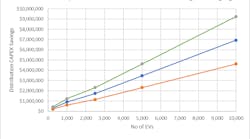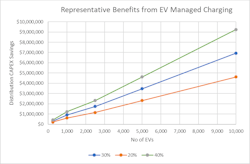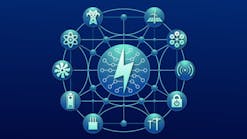Moving power from utilities to customers is a key role of the distribution system and electric utilities have been steadily increasing their investment in this segment of the grid. Over the past two decades, utility investment in the distribution system has doubled. In 2019, electric utilities in the United States spent more than US$50 billion on distribution system capital expenses. Up to 50% of those expenses were associated with installing devices for controlling load, voltage, phase angle, and frequency.
Voltage transformers are a ubiquitous part of the distribution system with millions of transformers installed throughout the country. Distribution transformers are a critical component of today's electricity systems. They "step down" the voltage from the primary distribution system to levels that can be used by residential and commercial customers.
Like other electrical devices, transformers only function for so long. An average transformer can function between 25 to 40 years. According to the American Society of Civil Engineers, nearly 70% of power transformers in the United States are 25 years or older. As transformers age, their ability to withstand operational stress degrades and this can result in higher transformer failure rates. For example, increased loads or voltage spikes on transformers can lead to overloads and significantly reduced transformer lifetimes with commensurate reductions in grid reliability.
Increasing loads are because of utility customers using more appliances and equipment that require more power than in the past. In addition, emerging distributed energy resources (DERs), such as rooftop solar photovoltaic (PV) systems and electric vehicles (EVs), perform in ways that pose unique problems to distribution systems and transformers. Even small increases in the number of EVs with their associated high charge rates can cause sudden and unexpected surge in loads on transformers, leading to overloads and outages.
A typical response by utilities to EV growth is increasing the number of transformers or adding larger transformers to support this additional load. An alternative approach would be to use advanced metering infrastructure (AMI) or smart meters in conjunction with advanced analytics for transformer characteristics. This approach identifies vulnerable transformers and then proactively takes steps to lower the associated EV load and voltage impacts. Premise and EV charge data can be obtained from Electric Vehicle Service Equipment (EVSE) charge data or from AMI (for example, disaggregated EV charging profiles). EV charging can then be orchestrated by selectively "throttling" and "staggering" the EVs located on the vulnerable transformers at off-peak hours, as shown in the figure below. Additional load reductions can be obtained by controlling other devices (for example, HVAC, pool pumps, battery storage), if available and needed. This approach can also prevent outages resulting from simultaneous "midnight charging" of EVs.
Benefits of Managing EV Charging
Over the past 20 years, while utility investment in distribution system infrastructure has been increasing, the amount of electricity sold by utilities has been decreasing because of improved energy efficiency measures and DERs such as rooftop PV. Essentially, while utilities were investing in the electric system to maintain high reliability, there was less revenue from electricity sales to cover the investment. This has been putting utilities at risk of developing CAPEX investments that require larger and larger rate base increases with decreasing electricity sales.
With an EV managed charging approach, customer-owned devices are treated as behind-the-meter resources that do not have to be owned by the utility. EV managed charging enables the utility to use the chargers to control loads and voltages, thereby preventing or deferring the need to install larger transformers. This approach improves the CAPEX position by reducing the costs of adding additional transformer capacity without the risks.
Today, a utility with 1.4 million residential customers may have distribution system CAPEX and OPEX of over US$300 million and over US$200 million annually, respectively. Edison Electric Institute (EEI) projects that 7.5 million Level-2 EV supply equipment (EVSEs) will be operating in residential neighborhoods in the United States by 2030. Utilities preparing for this expected growth using the typical response of adding more or larger transformers may increase distribution CAPEX and OPEX dramatically, leading to higher customer costs.
Economic analyses show that non-wires alternatives such as managed EV charging in conjunction with the active engagement of customers can provide positive benefits and be cost-effective for both the utility and its customers. Typically, owners of EVs are already environmentally conscientious and more willing to participate in programs that help reduce their costs so long as it does not impact the way they use their vehicle or leave them with inadequate charge in the morning.
A managed EV program starts by engaging customers to find out their EV charging preferences (that is, how many EVs do they own, when they normally leave in the morning, how much they typically drive each day, how much charge they prefer to have when they leave in the morning, when they typically get home, and when they usually plug in their EV). Based on customer preference and driving habits determined by EVSE data and a combination of EVSE and AMI data with advanced analytics, the program determines the best EV charging cycle (including throttling and staggering) that not only meets the customer's preferences but also reduces their EV charging costs while simultaneously reducing load and voltage surges on the transformer. This "light touch" strategy allows customers to save on their EV charging costs and eliminates the anxiety customers have while making decisions on when to charge. Importantly, because EV managed charging also simultaneously controls loads and voltages at the transformer, it provides benefits to both the utility and its customers.
The graph below illustrates the extent to which EV managed charging can help reduce utility distribution CAPEX. Each line on the chart represents the possible savings in CAPEX because of shifting EV charging from current levels of on-peak charging to off-peak. The lower line (orange) represents moving EVs that typically charge 20% of the charging time during peak hours to off-peak hours. The upper line (green) represents moving EVs that typically charge 40% of charging hours on-peak to all off-peak. The chart also reflects the additional increased CAPEX savings as the number of EVs increases. A program with 5000 residential Level-2 EVSEs would not only reduce customer costs but also translate to over US$2 million annually in cost savings to a utility.
A managed EV charging approach creates happier customers, protection against transformer overloads and other distribution system devices, thus extending their longevity and providing an even better return on investment by the utility on CAPEX. Savings because of the deferred CAPEX allows a utility to use the savings to further reduce customer costs or reinvest it into other CAPEX such as grid modernization.




